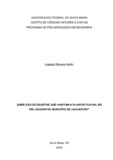| dc.creator | Mello, Isabela Silveira | |
| dc.date.accessioned | 2021-06-23T20:00:08Z | |
| dc.date.available | 2021-06-23T20:00:08Z | |
| dc.date.issued | 2020-01-31 | |
| dc.identifier.uri | http://repositorio.ufsm.br/handle/1/21201 | |
| dc.description.abstract | Floods are extreme precipitation events, so the riverside regions of the floodplains are prone to the impacts of major river floods. In the state of Rio Grande do Sul there are several cities that have a significant population residing on the banks of the rivers. In Jaguari, in the central region of the state, this phenomenon occurs at least once a year, where the river that names the city spills into its bed and its tributaries, forcing many families to leave their homes. As it is a small city with approximately 11 thousand inhabitants, flooding episodes recur and directly impact the lives of the people who live there. Most of the population affected by the floods of the Jaguari River, are inserted in low-income housing units and carry with them some indignation regarding the actions of the competent agencies. This research aimed to characterize and discuss who are the subjects affected by flooding in the city of Jaguari/RS, whether they carried characteristics of riverside populations or not. Through the case study methodology and the application of semi-structured questionnaires together with the quantitative approach, it is possible to reach satisfactory results that provided subsidies to answer the guiding question that started the work. Finally, from the analysis of the results it can be concluded that this population is in fact able to live in a space of social and territorial segregation, where they are not assisted by the city, rarely receive help from them and, therefore, are not organized in function of claiming improvements for its territory. | eng |
| dc.description.sponsorship | Coordenação de Aperfeiçoamento de Pessoal de Nível Superior - CAPES | por |
| dc.language | por | por |
| dc.publisher | Universidade Federal de Santa Maria | por |
| dc.rights | Attribution-NonCommercial-NoDerivatives 4.0 International | * |
| dc.rights.uri | http://creativecommons.org/licenses/by-nc-nd/4.0/ | * |
| dc.subject | Enchentes | por |
| dc.subject | Território | por |
| dc.subject | Segregação sócio territorial | por |
| dc.subject | Floods | eng |
| dc.subject | Territory | eng |
| dc.subject | Socio-territorial segregation | eng |
| dc.title | Quem são os sujeitos que habitam a planície fluvial do Rio Jaguari no município de Jaguari/RS? | por |
| dc.title.alternative | Who are the subjects that live in the Jaguari River plain in the municipality of Jaguari / RS? | eng |
| dc.type | Dissertação | por |
| dc.description.resumo | As enchentes são eventos extremos de precipitação, desta forma, as regiões ribeirinhas às planícies de inundação estão propensas aos impactos das grandes cheias dos rios. No estado do Rio Grande do Sul diversos são os municípios que contam com uma significativa população residindo as margens dos rios. Em Jaguari, na Região Central do Estado, este fenômeno acontece pelo menos uma vez por ano, onde o rio que dá nome a cidade extravasa seu leito e seus afluentes, obrigando diversas famílias a saírem de suas residências. Por ser um município de pequeno porte com aproximadamente 11 mil habitantes, os episódios de inundação são recorrentes e impactam diretamente a vida das populações que ali residem. Grande parte da população atingida pelas inundações do Rio Jaguari, estão inseridas em núcleos habitacionais de baixa renda e carregam consigo algumas indignações quanto a atuação dos órgãos competentes. Esta pesquisa teve o intuito de caracterizar e discutir quem são os sujeitos atingidos pelas inundações no município de Jaguari/RS, se estes carregavam consigo características de populações ribeirinhas, ou não. Através da metodologia do estudo de caso e da aplicação de questionários semiestruturados juntamente com a abordagem quantitativa pode-se chegar a resultados satisfatórios que forneceram subsídios para que fosse possível responder a questão norteadora que deu início ao trabalho. Por fim, a partir da análise dos resultados pode-se concluir que esta população na verdade está condicionada a viver num espaço de segregação sócio territorial, onde não são assistidos pela prefeitura, poucas vezes recebem ajuda dos mesmos e diante disto, não se organizam objetivando reivindicar melhorias para o seu território. | por |
| dc.contributor.advisor1 | Meurer, Ane Carine | |
| dc.contributor.advisor1Lattes | http://lattes.cnpq.br/6724702305350914 | por |
| dc.contributor.referee1 | Monguilhott, Michele | |
| dc.contributor.referee2 | Viera, Valmir | |
| dc.creator.Lattes | http://lattes.cnpq.br/9784504979478092 | por |
| dc.publisher.country | Brasil | por |
| dc.publisher.department | Geografia | por |
| dc.publisher.initials | UFSM | por |
| dc.publisher.program | Programa de Pós-Graduação em Geografia | por |
| dc.subject.cnpq | CNPQ::CIENCIAS HUMANAS::GEOGRAFIA | por |
| dc.publisher.unidade | Centro de Ciências Naturais e Exatas | por |



